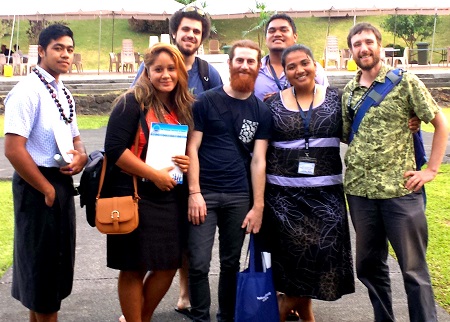
Archaeology students from American Samoa, including ASCC graduates Nolita Motu and Lindsay Ailma, and current ASCC student Visesio Hope, socialize with colleagues from overseas during the Third Samoa Conference held last month. (Courtesy Photo)

Archaeology students from American Samoa, including ASCC graduates Nolita Motu and Lindsay Ailma, and current ASCC student Visesio Hope, socialize with colleagues from overseas during the Third Samoa Conference held last month. (Courtesy Photo)
ASCC Archaeology Students Participate in SCIII
September 10, 2014
By James Kneubuhl, ASCC Press Officer
“It inspired me to pursue my future degrees in Archaeology and to become one of the professionals presenting research,” enthused American Samoa Community College (ASCC) spring 2014 graduate Lindsay Ailima, describing her participation in the recent Third Samoa Conference (SCIII) at the National University of Samoa (NUS) in late August. Following her graduation from ASCC, Lindsay plans to go on a mission for her church before continuing her college education at the University of Hawaii. While waiting for her mission to begin, Lindsay has taken the opportunity to further her knowledge of Archaeology, a subject which she recently developed a very keen interest in, by joining Dr. David Addison of ASCC; fellow ASCC graduate Nolita Motu, now attending North Dakota State University; and current ASCC student Visesio Hope for the Archaeology component of SCIII.
Along with Epi Suafo’a-Taua’I of ASPA, ASCC Archaeology instructor Dr. Addison co-presented a paper on the Tutuila Basalt Tool Manufacture and Export Industry. Nolita, who completed her AA in Teacher Education at ASCC in 2010 and her BA in Archaeology from UH Hilo in 2013, attend SCIII to present her graduate research on the usefulness of LiDar (Light Detection and Ranging) in Archaeology, which allows archaeologist to look at the ground surface image of the earth with no trees or vegetations visible. “Lindsay and Visesio’s participation came about because I’ve been mentoring them as future archaeologists,” explained Dr. Addison. “It was important for them to experience an academic conference and how research is presented in that setting. Also, I wanted them to interact with Nolita as a role model and peer mentor, and observe her presenting her research to professional colleagues.”
With its theme of “Opportunities and Challenges for a Sustainable Cultural and Natural Environment,” SCIII took place from August 26th – 29th, the week before the commencement of the United Nations Third International Conference on Small Island Developing States (SIDS). SCIII reflected on the theme of the SIDS conference in relation to sustainable development in small island states, at a time when small islands are uniquely challenged by the future impacts of climate change. SCIII embraced the concept of ‘sustainable development,’ exploring the question of how to sustain and protect Samoa’s past, present and future achievements in relation to the natural environment, culture, language, literature history, heritage, communications, science, health and education.
A sub-theme of SCIII was Samoan Cultural Heritage & Archaeology, and this portion of the event drew professionals from across the Pacific. “Connections and networking are very important because Pacific archaeologists form a relatively small community, and future research and educational opportunities often depend on knowing the people who can provide them,” said Dr. Addison. “This is especially important for our students, coming from a small and relatively unknown institution. That the conference took place at the NUS was an added benefit because our American Samoa students could connect with Archaeology students there, who will be their future colleagues on the other side of Samoa.”
“This conference was like a reunion for all professionals and young archaeologists from across the Pacific,” reflected Lindsay. “They reported, exchanged information, shared their experiences on what they found, and how they interacted with the environment while doing field research. The most valuable lesson I've learned from attending this conference is the importance of studying the material remains left by our ancestors. Only through studying what the ancient people in Samoa left behind can we learn the history of our ancestors and our culture. I've learned about, Lapita pottery, a shrinking land, the ancient people of Manono, automated archaeological feature identification on Tutuila and Manu’a, the disappearance of ceramics (clay pots) in Samoa, Tutuila ancient basalt tool manufacture and export, and so much more.”
Having attended three academic conferences so far and presented papers at two, Nolita spoke of how Archaeology addresses gaps in our knowledge of Samoa’s true history. “Our Samoan prehistory has always been a mystery to me, she said, “and Archaeology offers an opportunity to research, understand, and explain that mystery. It is another way to appreciate my Samoan culture.” Visesio, originally from Tokelau, intends on integrating Archaeology into his current focus on education. “I’m majoring in Teacher Education because Archaeology involves a lot of teaching,” he explained. “Tokelau knows very little about Archaeology, so I want to enter the field and show the people at home how important things from the past are.”
Funding for travel to the conference was provided by ASCC’s National Science Foundation Louis Stokes Alliances for Minority Participation program, which assists students in the STEM (Science, Technology, Engineering and Mathematics) areas, and by the ASCC Samoan Studies Institute. For more information on Archaeology course at ASCC, contact Dr. David Addison at 699-9155, ext. 354.
